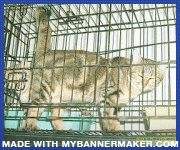Berikut ini adalah artikel berkenaan mengapa dan bagaimana untuk merawat arnab yang mempunyai masalah gigi yang memanjang lebih daripada saiz biasa. Di harap artikel ini dapat membantu rakan-rakan yang mempunyai masalah tersebut.
By Sari Kanfer, DVM and Alexandra Logsdon
Most people know that rabbits have four large incisors (front teeth), but not everyone realizes that they also have other teeth besides those large incisors. They have two tiny incisors located right behind the upper incisors. These are called peg teeth. In the back of their mouth they have six upper and five lower cheek teeth on each side. The incisors have a sharp edge and scissor-like action, and are mainly used to slice through vegetation; and the cheek teeth are used for grinding food into smaller pieces (chewing) for swallowing.
Rabbit teeth are similar to horse teeth. They have evolved over time to break down tough, fibrous vegetation, such as grasses, weeds, twigs and leaves, the natural forage of wild rabbits. To compensate for this constant wear, rabbit teeth are open-rooted, which means they grow continuously throughout their lives.
A rabbit whose diet is insufficient in fiber, such as a pellets-only diet, will be unable to properly wear down its teeth. When this happens, the crown (the visible section of the tooth) grows higher and meets the opposing tooth abnormally, leading to abnormal wear and the eventual development of sharp edges or points (also called spurs). Sharp tooth edges are painful and can get long enough to cut the tongue, or can cut the inside of the cheeks, causing soft tissue abscesses. When teeth don't occlude (meet) properly, it is called malocclusion. Maloccluded teeth create abnormal pressure against one another, which can cause the tooth roots to become impacted, elongated and inflamed. Tooth root impaction is extremely painful and will eventually lead to an infection in the bone, or "jaw abscess."
Once a rabbit has a malocclusion, it is likely that he will never have normal teeth, and may require frequent vet visits, regular tooth trims under anesthesia, and possibly even abscess surgery. With tooth trims and increased dietary fiber we can keep rabbits comfortable and provide them with a good quality of life. But tooth problems cannot be ignored - they will not get better on their own. Your best bet is early diagnosis and careful monitoring.
Normal Rabbit Teeth
 |

Some Commonly Asked Questions
How Do I Keep My Rabbit’s Teeth Healthy?
Yearly or twice yearly dental check-ups by your rabbit savvy vet, plus a healthy, high fiber diet are two important factors in keeping the teeth in good shape.
Hay is the most important part of your rabbit’s diet, not only because of the necessary fiber content that keeps the gut functioning properly, but also because it requires a great deal of chewing. We also believe, from hours of observing both domestic and wild rabbits, that it is important to offer your rabbit a daily variety of hays. Why? Because different hays have different textures, and different hay textures require different chewing mechanics, and thus help to keep those ever-growing teeth worn down naturally. Limiting the pellets that you feed your rabbit is important, because it will help encourage your rabbit to eat more hay, rather than filling up on the less fibrous food.
It is also helpful to offer your rabbit tough, fibrous tree branches, leaves and twigs. It is important to make sure you gather these from rabbit-safe trees and bushes that have NOT been chemically treated with fertilizers, pesticides or herbicides. While wooden chew blocks are fun to play with and great for the front teeth (if your rabbit chews on them), they are not particularly useful for the back teeth.
Some rabbit-safe chewables you may find in your yard:
• Orange or lemon trees – branches may be fed fresh or dried
• Apple trees – branches may be feed fresh or dried
• Willow - branches may be fed fresh or dried
• Maple, Ash and Pine trees – branches should be dried
• Rose Canes – remove thorns, branches and leaves may be fed fresh or dried
You may want to rinse the branches in water, or place in the freezer overnight to kill any bugs.
To Sum Up: Both the rabbits front and back must be considered for good dental health. To help keep the teeth properly worn down, a rabbit must use them almost constantly; munching on hay throughout the day, as well as offering frequent branches, twigs and dried leaves helps to accomplish this.
How do I know if my rabbit has bad teeth?
Yearly (or more) visits to a rabbit-experienced veterinarian are essential. The veterinarian can do a fairly decent dental exam on an awake rabbit using a special mouth cone and good palpation, but a complete and thorough oral exam requires anesthesia. When your rabbit is under anesthesia to be spayed or neutered, this is an excellent time for the doctor to do a thorough oral exam. And of course, when a problem is suspected a complete oral exam, including skull x-rays, is indicated.
What can I do at home, on a regular basis, to monitor my rabbit's teeth?
- Make sure your rabbit eats his daily pellet and veggie portions eagerly, and that he munches on his hay frequently throughout the day.
- Note any changes in your rabbits eating habits: no longer eating produce, ignoring pellets or having a hard time chewing them, eating less hay than usual, abnormal feces.
- Feel the left and right sides of your rabbit’s head - in front of the eyes, below the eyes on the cheekbone, and under the lower jaw. If you feel a lump on one side that is not on the other, go to your rabbit vet as soon as you can.
- Gently lift up upper lips to look at the incisors - do they meet evenly? If not, give your vet a call.
- Check for any drooling or excessive wetness under chin (but don't worry if your rabbit has a moist chin for a short time after drinking or after eating vegetables).
- If your rabbit gives bunny kisses, you can smell his breath. A rotten odor is reason for a vet check. Beware - parsley-breath is nice, but cecotroph-breath can be pungent!
- Eye and/or nasal discharge can also be a sign that something is wrong with your rabbit's teeth.
My rabbit is eating and not showing any signs of pain, doesn't that mean his teeth are healthy?
NO! Rabbits are prey animals. This means that in the wild everything eats them, and if they show signs that they are ill, they are more likely to be targeted for dinner. Our domestic rabbits hide their pain in much the same way: This is why rabbits are so (frighteningly) good at hiding illnesses and why we as owners must be so diligent in observing them for small changes, as well as making sure that they get frequent vet check-ups and good vet care as-needed. Many rabbits have huge abscesses, or tongues nearly cut in half, before they start to show signs like drooling or decreased appetite. This is why its so important to have your rabbit's mouth checked regularly by a rabbit experienced vet.
Rabbits have the potential for many tooth problems, which can affect their lifelong health. This is why it is so important to be observant, proactive and diligent about preventative care.
Dr. Sari Kanfer practices at Animal Medical & Dental Group in Manhattan Beach and can be reached for appointments or consultations at (310)546-5731. She joined the board of Zooh Corner as Medical Director in January of 2002.
Alexandra Logsdon has run Zooh Corner Rabbit Rescue since 1993 and has many years of practical experience. She may be reached via e-mail alex@mybunny.org, or via the website www.mybunny.org
Zooh Corner Rabbit Rescue
www.mybunny.org
(909)868-BUNI















No comments:
Post a Comment